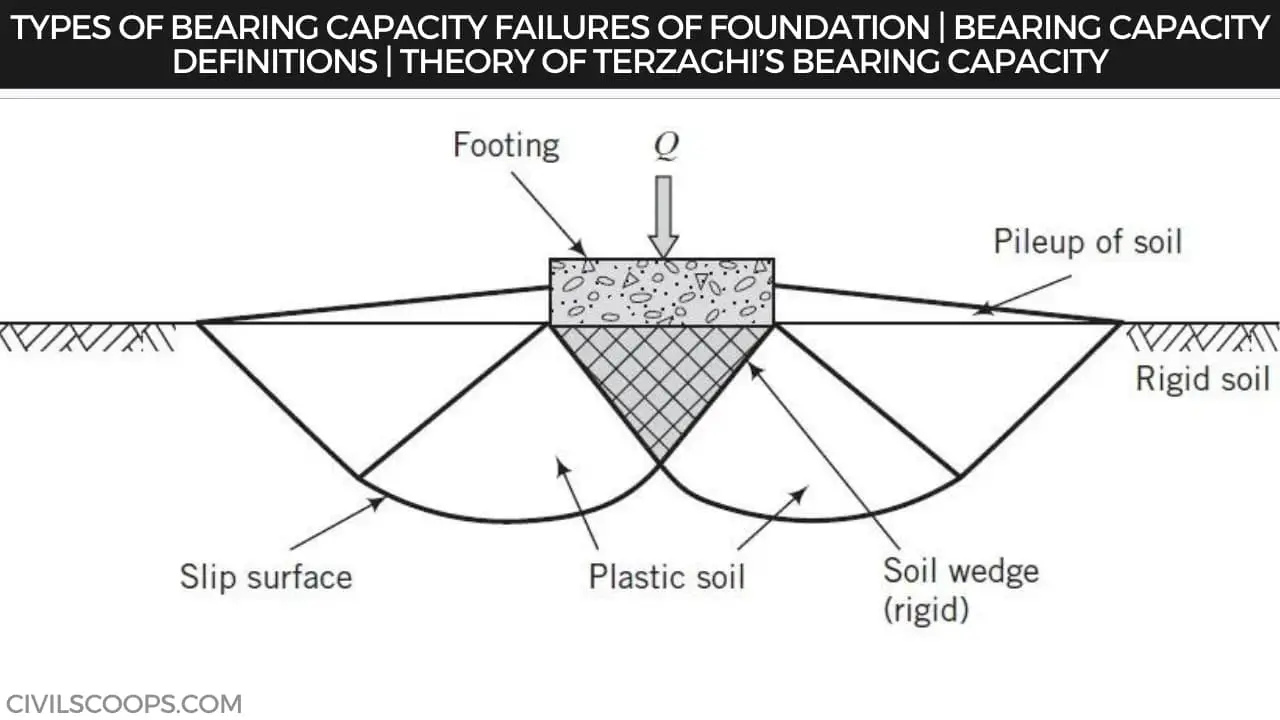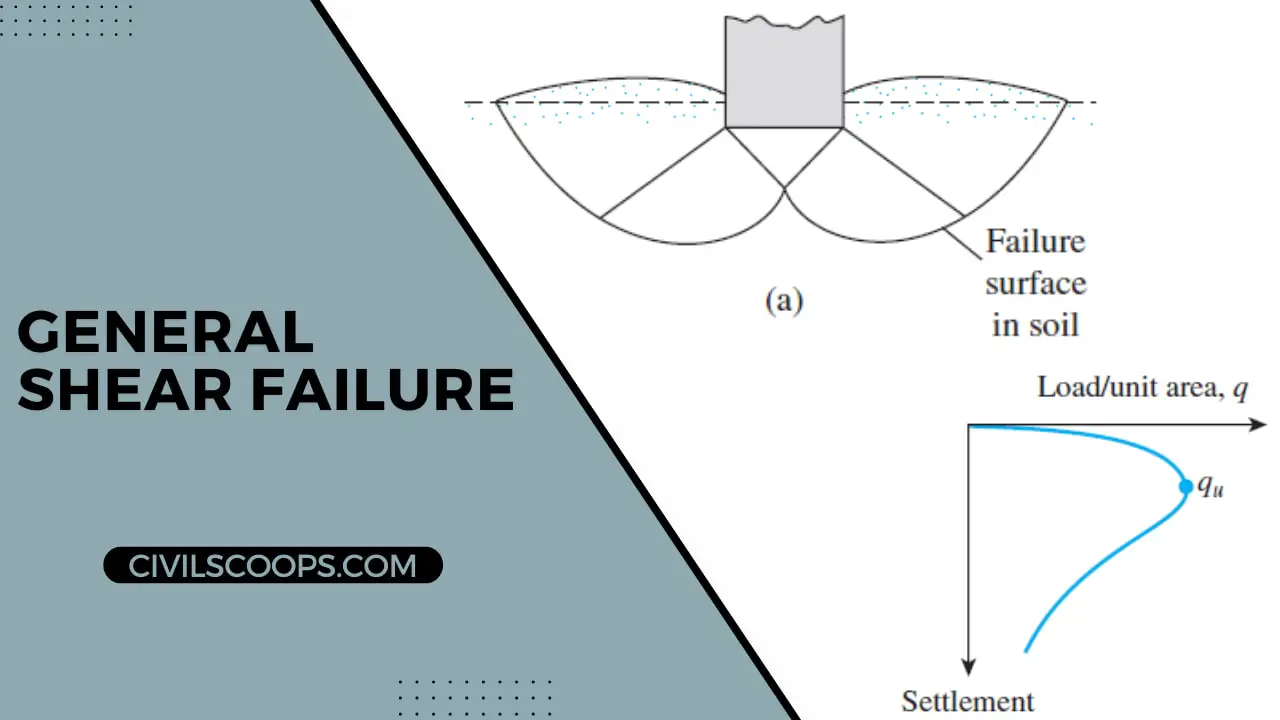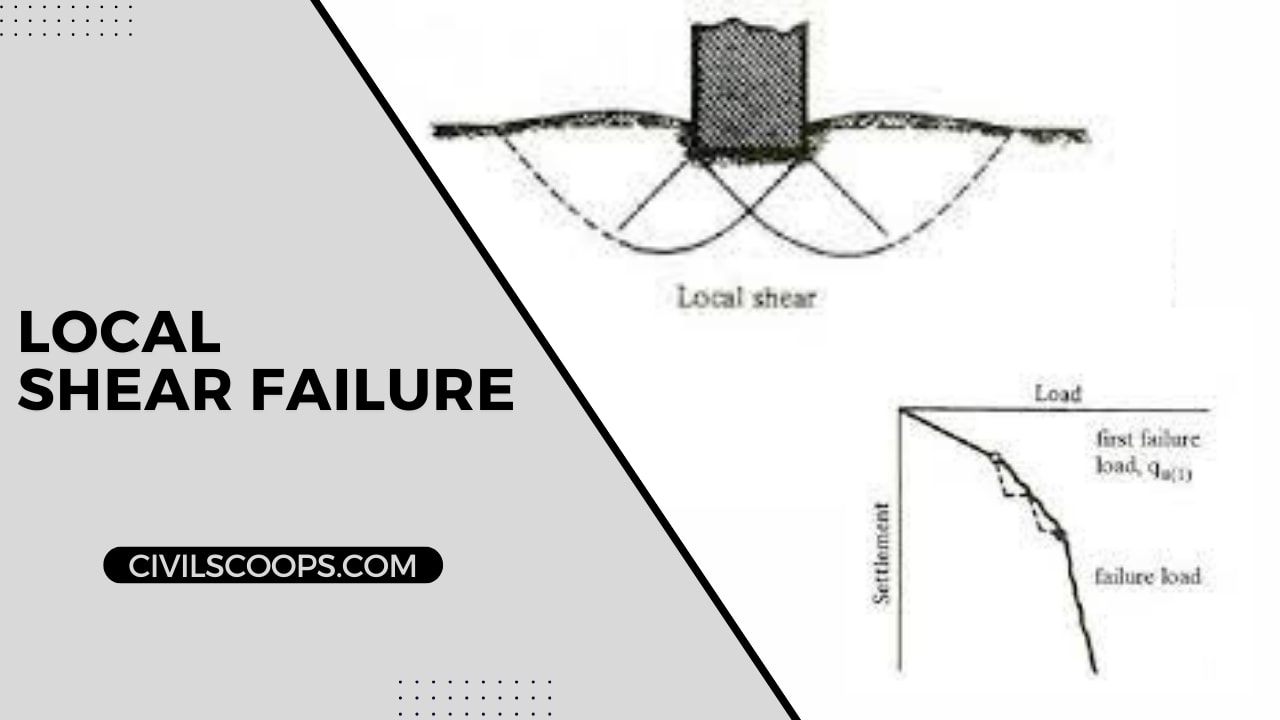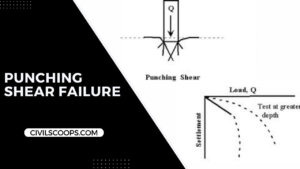Types of Bearing Capacity Failures of Foundation | Bearing Capacity Definitions | Theory of Terzaghi’s Bearing Capacity

Table of Contents
Bearing Capacity Definitions
Bearing capacity: It is the loading capacity of the soil. Ultimate bearing capacity (qu): That is the least gross pressure that will result in the shear collapse of the supporting soil directly below the foundation.
Net ultimate bearing power (qun): it is the net strain that can be added to the foundation by external loads that can only initiate the collapse of the underlying soil. That is equal to the ultimate carrying potential minus the stress due to the weight of the foundation an overload immediately above it. Assuming that density (concrete), and soil density (are similar enough to be treated equal, then
qun = qu – Df
Where,
Df = Depth of the footing,
- Safe bearing capacity: This is the ability to hold after adding the factor of safety (FS). They are of two kinds,
- Net bearing capacity (qns): That is the net surface pressure that can be added to the soil in the event of shear failure. It is provided by the
- Safe gross capacity(qs): That is the highest gross pressure that the soil can bear safely without shear failure. It is given below,
qs = qns + Df
- Allowable bearing pressure: It is the highest pressure of the soil deprived of any shear collapse or failure of settlement.
Techniques for Evaluating Bearing Capacity
The different methods for measuring the potential of the bearing can be set as provided.
- Presumptive Analysis.
- Analytical Methods.
- Plate Bearing Test.
- Penetration Test.
- Modern Testing Methods.
- Centrifuge Test.
Theory of Terzaghi’s Bearing Capacity
Assumptions in the Bearing Capacity Principle of Terzaghi
- The depth of the foundation is less than or equal to the width of the foundation.
- The foundation base is coarse.
- The soil just above bottom of the foundation has little shear strength; it is just an overload it against overturning load.
- Surcharge up to the foundation base shall be considered.
- Load added is vertical and non-excentric.
- The soil is homogeneous and isotropic.
- The ratio of L/B is infinite.
Consider a foundation of width B and depth weighted with Q and lying on soil of unit weight. The failure zone is split into three
sections, given below.
- Zone 1 is an aggressive Rankine zone. The active Rankine is at the angle of 45 + Ø/2
- Zone 2 are the radial shear zones And form one set in the shear pattern. It zones release from outer edge of the centre of the base of the foundation.
- Zone 3 is a passive zone. These are at 45 + Ø/2, the horizontal.
Although the base is rugged, the surface between the base and the two sliding surfaces exists in a balance and it became an arrangement part.
The surfaces are rising to the horizontal. At the moment of failure, the strain from each ground is proportional to the product of the PP passive earth pressure and the cohesion force Ca. If the slip happens around these faces, the resulting earth pressure works to the normal around each face in a vertical direction. If the weight of the soil is not taken the balance of the soil demands that
Qd = 2Pp +2Ca SinØ = 2Pp + Bct tan Ø
The passive pressure desirable to create a slip may be categorized into two sections. The force reflects the resistance due to the weight of the mass. The fact of implementation shall be located at the lower third point. The force is at the midpoint of the touch surface. The value of the bearing power can be determined as:
Qd = 2 [Pp + Pc + Pq +( 0.5 Bc tan Ø)]
Introducing the following values into eqn (2):
- Nc = (2Pc/Bc) + tan Ø
- Nq = (2pq/BγDf)
- Nγ = (4Pq/B2γ)
Quantities are denoted as the bearing capacity factors.
Bearing Capacity Failures
Failures of bearing capacity are considered as a base failure which happens when the shear of stress in the soil exceeds the shear strength of the soil.
Types of Bearing Capacity Failures of Foundation
Here, the different types of bearing capacity failure of foundation are as follows.
- General Shear Failure.
- Local Shear Failure.
- Punching Shear Failure.
1. General Shear Failure

A strip footing lying on soft clay and loose sand. In the ground, shear failure happens at the load and the failure surface spreads to the surface of the ground. Whenever this failure mode is denoted as a general shear failure. In general shear failure, a heave is regularly detected on the sides. A continuous, well-defined, and distinct surface of failure forms between the edge of the base and the ground surface.
Dense or rigid soil undergoing low compressibility suffers this loss. The constant bulging of the shear mass adjacent to the foot is evident. Failure is accompanied by a tilting of the foot.
Failure is abrupt and devastating, with a sharp curve top. The length of the disruption beyond the edge of the foot is high. The form of plastic balance is originally attained at the foot edge then finally stretches down and out.
General shear failure is followed by low strain (<5 percent) in soil with considerable (>360) and broad N (N >30) with high relative density (ID >70 percent).
2. Local Shear Failure

The strip footing laying on medium-consistency clay or medium-dense sand. The acceleration of the foundation is followed by abrupt shocks when the load is equal to a certain Qu value.
Failed surfaces increasingly expand outwards from the foundation. Even so, in happening of the collapse of surfaces, an extensive measure of the foundation is compulsory to extend to the surface of the earth.
The load at which this occurs is equal to Qu‘s. After that point, the rise in legislation is followed by substantial growth in settlements. This types of failures are recognized as local shear failures. Where there is a significant vertical position, the only heave is observed.
Substantial soil compression below the foundation and partial production of the plastic balance is observed. Failure is not immediate, and there is no tilting of the foundation.
Weakness of the surface does not meet the surface of the earth and a minor bulging of the soil at the foundation is found. Failure of the surface is not clearly established. Failure is marked by a significant determination.
There is no well-defined peak in the curve. Local shear failure is followed by a large strain (>10 to 20 percent) of soil with a slightly low (<28o) and low N (N<5) relative density (ID>20 percent).
For local shear failure, the bearing capacity is found by the following equation:
qu= c’Nc‘ + γDNq‘ + 0.5 γBNγ‘
For local shear failure, the local shear limits as assumed below are used to compute the ultimate bearing capacity:
- c’ = (2/3)c
- tanɸ’= (2/3) tanɸ’
- Nc‘, Nq‘, and Nγ‘ are the bearing capacity factors corresponding to ɸ’.
3. Punching Shear Failure

The punching shear is a failure issue in structural members such as slabs and shearing under the action of concentrated loads. A strip footing lying on thick mud or loose sand. Throughout this scenario, the fault surfaces may not reach the ground surface.
At the load of Qu, the foot struggles, and at this fact the load-setting curve becomes steep and functional linear. This form of failure is known as a punching shear failure. When we’ve seen, even more so, there’s just a vertical rotation of the base.
This form of loss occurs in soils with very high compressibility. Failure patterns are not found. There is no bulging of soil at the foundation. Loss is marked by very great settlements.
A constant settlement with no rise is found in the curve. A cylindrical control surface shall be called around the burdened area or the column area at a specific distance. This distance is equal to the depth of the slab.
The average shear stress on the control surface shall not exceed the specification power. Often this design strength is equal to the tensile strength. The results of the moment transfer at the column or slab junction are facilitated by the organization of the punching shear. The measurement of the punching shear is based on numerous standards.
These criteria are pieces that are at a specific distance from the face of the column. Of the numerous portions, the most vital things are on the face of the column and at a distance of d/2 on each side of the column.
If the shear stress in these parts exceeds the acceptable stress value, the assembly would be subjected to a punching failure. Design formulas and parameter distances will differ from one code to another. However, the idea behind the measurement of punching shear loss is the same.
[su_box title=”FAQ” style=”default” box_color=”#333333″ title_color=”#FFFFFF” radius=”3″ class=”” id=””]
Types of Bearing Capacity Failures of Foundation
Bearing capacity failures of foundations can be grouped into three categories, as follows:
- General Shear Failure.
- Local Shear Failure.
- Punching Shear Failure.
General Shear Failure
The general shear failure is characterized by rupture of the underlying soil followed by bulging of soil surface around the footing. In field conditions, the soil is often heaved up on only one side of the footing followed by tilting of the structure.
Local Shear Failure
A significant compression of soil below the footing and partial development of plastic equilibrium is observed. Failure is not sudden and there is no tilting of footing. Failure surface does not reach the ground surface and slight bulging of soil around the footing is observed.
Punching Shear Failure
Punching shear is a phenomenon where a concentrated force on a slab causes a shear failure cone that “punches” through. Punching shear calculations require a demand value and a capacity value. Many hand calculations will consider a punching shear force against a punching shear capacity force.
Types of Shear Failure.
Bearing capacity failures of foundations can be grouped into three categories, as follows:
- General Shear Failure.
- Local Shear Failure.
- Punching Shear Failure of foundation soils.
Soil Bearing Capacity and Type of Foundation
In a nutshell, bearing capacity is the capacity of soil to support the loads that are applied to the ground above. It depends primarily on the type of soil, its shear strength and its density. It also depends on the depth of embedment of the load – the deeper it is founded, the greater the bearing capacity.
Punching Shear Failure Formula
On the other hand, the punching shear strength depends of the column location on the footing, either interior, edge or corner, per the expression φVc = φ Min(2+4/β, αs d/bo+2, 4) √f’c, where β is the column aspect ratio and αs is the column location factor.
Punching Shear Failure in Footing
Punching shear failure occurs when relatively high compression of the soil beneath the footing takes place, along with shearing in the vertical direction around the edges of the footing. As seen in Figure 1-2a, the distinct shear surfaces do not develop as in case of general shear failure.
How to Prevent Punching Shear Failure?
To overcome the punching failure problem, there are many ways to increase the punching shear strength of concrete slabs, increasing slab thickness in the area adjacent to the column, increasing column thickness which is against the architectural desire, and finally providing slab with shear reinforcement.
Punching Shear Failure in Flat Slabs
Static punching shear failure occurs in a flat slab near the column circumference, when the load transferred to the slab-column connection exceeds the connection capacity to carry the load safely and transfer it to the supporting column.
Punching Shear Reinforcement
The weight of a slab supported on a column induces shear stresses in the slab. These stresses, if sufficient and where additional reinforcement is not provided, would result in the column ‘punching’ through the slab.
Punching Shear Stress
Punching shear arises when a concentrated load is applied to a small area of a slab or, most commonly, the reaction of a column against a slab. The resulting stresses are verified along defined control perimeters around the loaded area.
What Is Local Shear Failure?
A significant compression of soil below the footing and partial development of plastic equilibrium is observed. Failure is not sudden and there is no tilting of footing. Failure surface does not reach the ground surface and slight bulging of soil around the footing is observed.
Example of General Shear Failure
In general shear failure of soil, sudden collapse occurs, accompanied by tilting of the footing. This type of failure occurs in case of dense sand or stiff cohesive soil supporting the footing. Failure load is well defined in this case.
[/su_box]
[su_note note_color=”#F2F2F2 ” text_color=”#333333″ radius=”3″ class=”” id=””]
Like this post? Share it with your friends!
Suggested Read –
- What Is Workability | What Is Workability of Concrete | Types of Workability of Concrete | Factors Affecting Workability of Concrete
- What Is Combined Footing | Types of Combined Footing | Advantage & Disadvantage of Combined Footing | Application of Combined Footing
- What Is Grouting | Type of Grouting | Experiment of Grouting | Characteristics of Grouting | Types of Grout for Ceramic Tile | Advantage of Grouting | Disadvantage of Grouting
- What Is Grade of Concrete | Concrete Mix Ratio | Type of Concrete Mix | Different Types of Concrete Grade with Concrete Mix Ratio and Compressive Strength | Uses of Different Grades of Concrete
- What Is Hidden Beam | Why Is It Used | Where Is It Used in Buildings | How to Design a Hidden Beam | Purpose of Hidden Beam | Advantages of Hidden Beam | Disadvantages of Hidden Beam
[/su_note]
Originally posted 2022-07-29 15:17:51.
